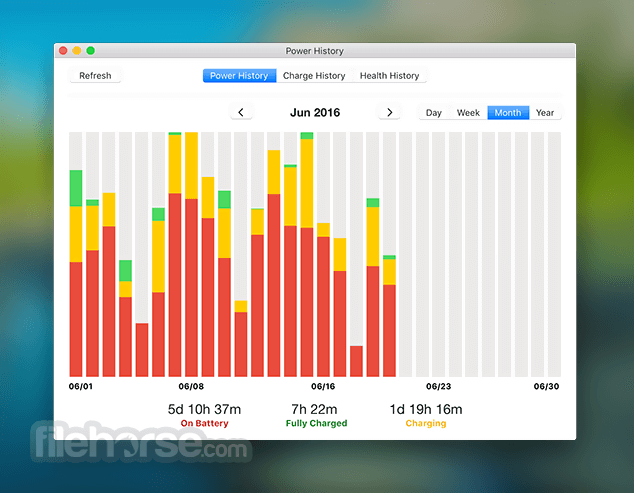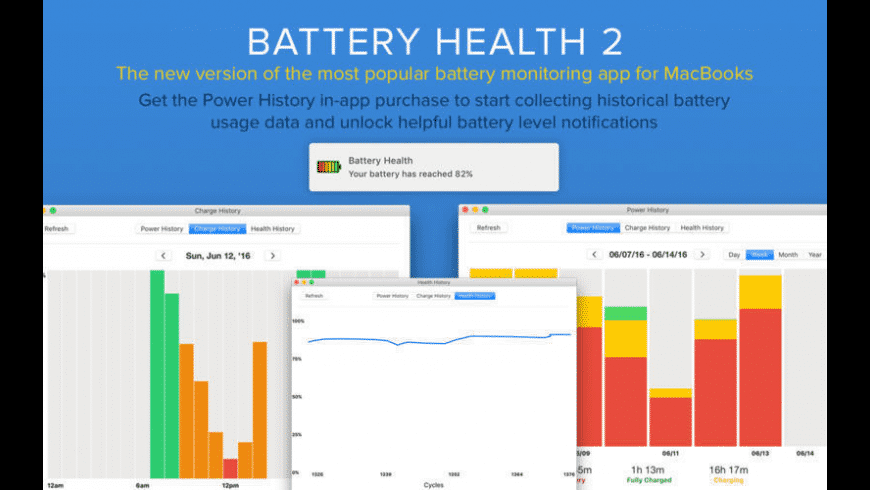BattStat is a battery status monitor and power management application for Windows 7/Vista/XP/2000 x86/x64. Primarily for laptops, it is small, mature and robust, and has been distributed since 2005 via public download.
Apple has released macOS 10.15.5 Catalina, adding battery health management for recent Mac laptops, eliminating the bouncing tiles in Group FaceTime, providing controls for fine-tuning the color calibration of the Pro Display XDR, and fixing a variety of bugs. It’s a 2.98 GB download via Software Update; the combo update clocks in at 4.8 GB.
Battery Health Management
I always feel irrationally disappointed when batteries in my electronics start to show significantly reduced charge life. It makes scientific sense that batteries age chemically, but intuitively, it’s hard to accept that charging today doesn’t have the same effect as charging several years ago.
Apple designed macOS 10.15.5’s new battery health management capabilities to reduce the rate at which batteries chemically age. It works by monitoring your battery’s temperature history and charging patterns to adjust the maximum level to which it will charge the battery.
Unfortunately, prolonging the overall lifespan of the battery comes with a tradeoff—a reduction in the amount of time your Mac will run on battery before needing to be plugged in. Since you may—either generally or at specific times—wish to maximize runtime, you can disable battery health management in System Preferences > Energy Saver. Click the Battery Health button, deselect Battery Health Management, and click Turn Off when prompted.
Finally, Apple notes that the limited maximum capacity may cause your battery status menu to indicate that you need to replace your battery.
The Battery Health button doesn’t appear in Energy Saver for my 2012 MacBook Air, which threw me initially but was explained by nbeadman on TidBITS Talk. He pointed out that, in a Six Colors post from 16 April 2020, Jason Snell noted that this feature was limited to Mac laptops with Thunderbolt 3 ports. That equates to all MacBook Pro models released since late 2016 and the Retina-capable MacBook Air models released since 2018. There’s no connection between Thunderbolt 3 and this feature—Apple is merely using the common denominator of Thunderbolt 3 support as a way of specifying which models are new enough to have the necessary internal hardware support.
Other New Features
The 10.15.5 update offers two additional new features:
- As with iOS 13.5 and iPadOS 13.5 (see “Apple Tailors iOS 13.5 and iPadOS 13.5 to a COVID-19 World,” 20 May 2020), Apple has added an option to Group FaceTime (in FaceTime > Preferences > Settings) to prevent video tiles from changing size when a person on the call speaks. That will make Group FaceTime easier to stomach, though the experience still leaves much to be desired (see “Videoconferencing Options in the Age of Pandemic,” 2 April 2020).
- If you have a Pro Display XDR, 10.15.5 reportedly adds controls to fine-tune the built-in calibration by adjusting the white point and luminance to your own display calibration target. For a monitor that costs $6000, you should be able to tweak individual pixels.
Bug Fixes
Apple's battery site says a 'normal battery is designed to retain up to 80% of its original capacity' and that a one-year warranty includes service if your battery is defective. But a one-year old. To know your battery health in details you would need a third-party software that will not just show you all the added details regarding the battery but will also ensure that you get the max performance out of your battery. Here’s a list of some of the best software to run a laptop battery health check. Tap Battery Health. Which can give you a sense of whether you should start carrying a USB battery pack or pay to replace the battery. Apple will replace a battery under the included one-year.
The list of bugs fixed in 10.15.5 includes some that have been annoying. In particular, the update:
- Fixes a bug that could prevent Reminders from sending notifications for recurring reminders
- Addresses a bug that could prevent password entry on the login screen
- Fixes a bug that caused System Preferences to show a notification badge even after installing an update (this was just discussed on TidBITS Talk)
- Resolves a bug that prevented the built-in camera from being detected when trying to use it after using a video conferencing app
- Addresses a bug with Macs with the T2 security chip that may prevent internal speakers from appearing as a sound output device in Sound preferences
- Fixes a stability problem with uploading and downloading media files from iCloud Photos while your Mac is asleep
- Resolves a stability bug when transferring large amounts of data to RAID volumes
- Fixes a bug that prevented the Reduce Motion Accessibility preference from reducing the speed of animations in a FaceTime group call
Sadly, no mention was made of the problems that some Mail users have had with data loss after upgrading to Catalina. We’ll have to wait for Michael Tsai’s users to weigh in with the results of their testing (scroll to the bottom of the comments).
And as expected, macOS 10.15.5 comes with fixes for 45 security vulnerabilities.
Should You Update? Should You Upgrade?
I wish I could change our general recommendations, but until we know more about the Mail bugs, I can’t. So, if you’re already running Catalina, either because you’ve upgraded or purchased a new Mac, let this update settle for a few days to see if it causes any troubles. It’s better to let others discover such problems and report back. Then install the update—the new features and bug fixes are all welcome.
We’re particularly intrigued to see how the battery health management feature works, but that’s going to be a long-term play. It will be difficult to assess how much it helps because no one outside Apple likely has a sufficient test suite of Macs to run for months.


Whether to upgrade from 10.14 Mojave (or earlier) is another question. We’re probably within one or two more bug fix updates for Catalina before Apple moves on to the next major version of macOS.
Assuming, that is, that Apple sticks to its usual schedule during these uncertain times and with engineers working from home. It’s conceivable that Apple could delay the next version of macOS for as much as a year. Alternatively, the company could move on to a newly named version to escape the somewhat cursed Catalina moniker but focus on cleaning up the problems in Catalina. (When it comes to new names, I’m voting for “Avalon,” which is the only city on Catalina Island and part of Arthurian legend.)
Regardless, if you haven’t yet upgraded to Catalina, my recommendation now is that you should wait until the end of June, after Apple’s Worldwide Developers Conference, which starts on 22 June 2020. The news that comes out of WWDC should provide some updated guidance.

About the lithium-ion battery in your Mac notebook
Mac notebook batteries use lithium-ion technology. Lithium-ion batteries charge quickly, are long-lasting and currently provide the best technology to power your computer.
All rechargeable batteries are consumable components that become less effective as they get older – and their age isn't determined only by time. A battery's lifespan depends on its chemical age, which is affected by factors such as its temperature history and charging pattern. As your notebook's battery ages chemically, its charging capacity gets smaller.
With these tips for maximising battery performance, you can get the most out of all of your Apple devices. And with battery health management, your Mac notebook can take battery optimisation even further.
How battery health management helps

The battery health management feature in macOS 10.15.5 is designed to improve your battery's lifespan by reducing the rate at which it ages chemically. The feature does this by monitoring your battery's temperature history and charging patterns.
Based on the measurements it collects, battery health management may reduce your battery's maximum charge when in this mode. This happens as needed to ensure that your battery charges to a level that's optimised for your usage – reducing wear on the battery and slowing its chemical ageing.
While battery health management benefits your battery's long-term lifespan, it can also reduce the amount of time your Mac runs on one battery charge when capacity limits are applied. If your priority is making your Mac notebook last as long as possible before recharging, you can turn the feature off.
When battery health management is turned on, your battery's maximum charging capacity might be limited. Although the feature is designed to improve your battery's lifespan, the limited maximum capacity might update your battery status menu to indicate a need for service.
How to control the battery health management feature
Battery health management is on by default when you buy a new Mac notebook with macOS 10.15.5, or after you upgrade to macOS 10.15.5 on a Mac notebook with Thunderbolt 3 ports.
If you want to turn it off, follow these steps:
- Choose System Preferences from the Apple menu , then click Energy Saver.
- Click Battery Health.
- Deselect Battery health management, then click OK.
- Click Turn Off.
Note that turning this feature off might reduce your battery's lifespan.
Mac Battery Cost
Learn more
Mac Battery Health App
If you feel that your battery isn't lasting as long as it should, you can find out about servicing for your Mac notebook.

Comments are closed.